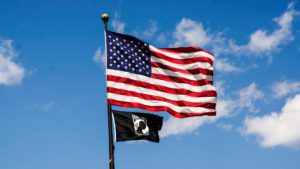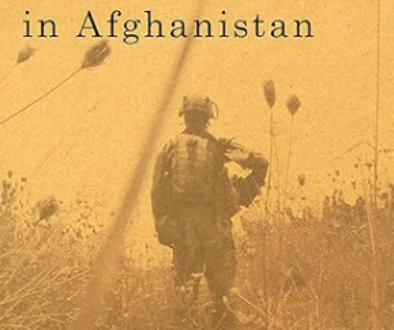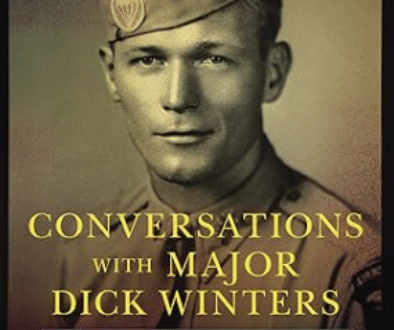Salute or Stand During the National Anthem – Part II
Since I wrote Salute or Stand at Attention During the National Anthem on July 17, 2017, I’ve received more questions about what the rules are for veterans saluting the flag of the United States than any other subject. Given that, I thought I would provide a “just the facts” summary of the statutes enacted by Congress indicating the options veterans have for showing their respect for the flag. Here’s what Congress says.
During the Pledge of Allegiance
Congress spells out the Pledge of Allegiance to the Flag of the United States in Section 4 of Title 4 to the U.S. Code (abbreviated 4 U.S.C. §4):
“I pledge allegiance to the Flag of the United States of America, and to the Republic for which it stands, one Nation under God, indivisible, with liberty and justice for all.”
After making sure the language of the Pledge is clear, Congress prescribes that when reciting the Pledge, you should stand at attention facing the flag and place your right hand over your heart. However:
- Men not in uniform should remove any non-religious headdress with their right hand and hold it at their left shoulder, so that their right hand is over their heart. You can draw several conclusions from this provision. First, it is respectful for men not in uniform wearing religious headdress to leave it on while saying the Pledge. Second, women not in uniform may properly wear head coverings, religious or not, while saying the Pledge.
- Persons in uniform should remain silent, face the flag, and render the military salute. This means persons in uniform do not recite the pledge—they salute while others are reciting it.
- Members of the Armed Forces not in uniform and veterans may render the military salute in the same manner as persons in uniform. In this instance, Congress made the military salute optional. Congress also did not require that persons wearing head coverings remove them. If members of the Armed Forces not in uniform or veterans choose not to salute, they should follow the procedures for persons not in uniform in the first bullet, above.
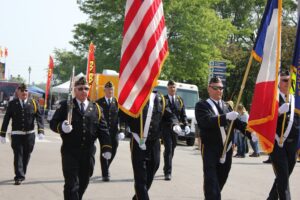 When the Flag is being Hoisted, Lowered, or it Passes By
When the Flag is being Hoisted, Lowered, or it Passes By
The rules for flag hoisting and lowering ceremonies, as well as what spectators should do when the flag passes by in a parade or review, are set forth in 4 U.S.C. §9. Specifically, for those situations, Congress instructed that:
- All persons present in uniform should render the military salute.
- Members of the Armed Forces and veterans who are not in uniform may render the military salute. The statute does not require that these persons remove their hats if they are wearing one. There is nothing in the statute that prevents these persons from removing their hats and rendering a salute if they prefer.
- All other persons except citizens of other countries should face the flag and stand at attention with their right hand over the heart, or if applicable, remove their headdress with their right hand and hold it at the left shoulder, the hand being over the heart.
- Citizens of other countries should stand at attention.
All such conduct toward the flag in a moving column should be rendered at the moment the flag passes.
During the National Anthem
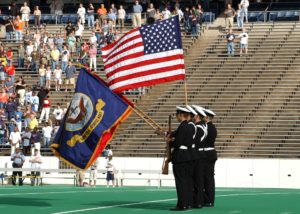 Although I covered what options veterans have when the National Anthem is played in my July 17, 2017, article, I’ll restate the rules found in 36 U.S.C. §301 so all of the rules about veterans’ options for saluting the flag are in one place.
Although I covered what options veterans have when the National Anthem is played in my July 17, 2017, article, I’ll restate the rules found in 36 U.S.C. §301 so all of the rules about veterans’ options for saluting the flag are in one place.
- If the flag is being displayed while the National Anthem is being played:
-
- Individuals in uniform should give the military salute at the first note of the anthem and maintain that position until the last note.
- Members of the Armed Forces and veterans who are not in uniform may render the military salute in the manner provided for individuals in uniform. The statute does not require these persons to remove their hats, nor does it prohibit them from doing so.
- All other persons should face the flag and stand at attention with their right hand over the heart, and men not in uniform, if applicable, should remove their headdress with their right hand and hold it at the left shoulder, the hand being over the heart. Nothing in the statute would prohibit women from removing their hats and holding them in the same manner as men are required to do.
- When the flag is not displayed, all present should face toward the music and act in the same manner they would if the flag were displayed.
During a Military Funeral
 Congress has not provided statutory guidance for veterans saluting at funerals. However, since I have received several questions relating to funerals, I will quote guidance provided by the American Legion.
Congress has not provided statutory guidance for veterans saluting at funerals. However, since I have received several questions relating to funerals, I will quote guidance provided by the American Legion.
- “During a funeral in which the casket is draped with a United States flag, what is proper conduct?”
- “[T]he following is generally acceptable out of respect to the deceased and reverence to the flag.”
-
- “Mourners should stand at attention and hold [their] headdress over [their] left breast at any time the casket is being moved by the pallbearers and during the service at the grave, including the firing of volleys and the sounding of Taps. During prayer they will also bow their heads. In cold or inclement weather, they will remain covered.”
-
- “Those in uniform render the military salute when the casket is being moved by the pallbearers and during the firing of volleys and the sounding of Taps.”
Summary
Thanks to everyone who has asked questions about how veterans may demonstrate their respect for the flag. What impresses me most is that Congress thought the issue important enough to enact laws giving veterans options for saluting the flag. Now that I know what my options are, I will exercise them with pride, and I hope you will to. Finally, feel free to share this article with other veterans so they will be aware of their options, too. As veterans, they’ve earned them!
